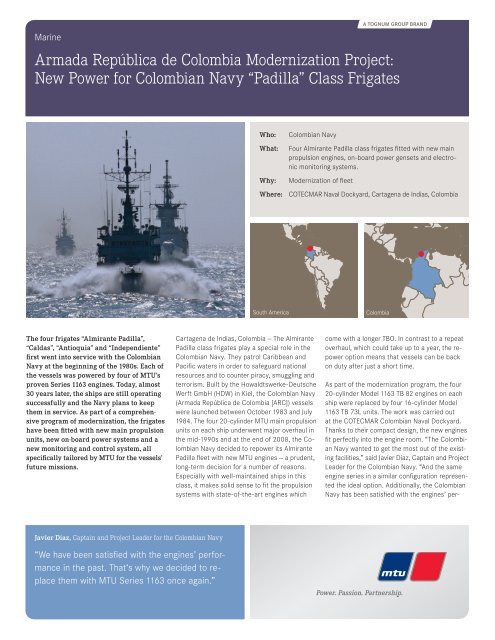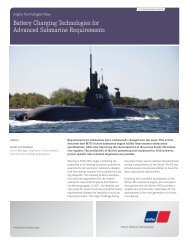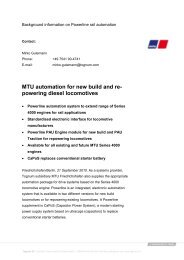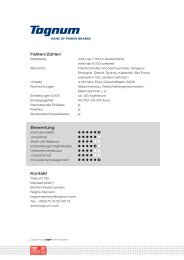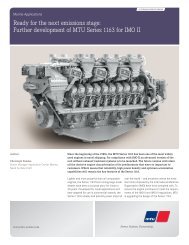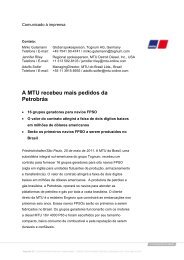No Title for this magazine
You also want an ePaper? Increase the reach of your titles
YUMPU automatically turns print PDFs into web optimized ePapers that Google loves.
Marine<br />
Javier Diaz, Captain and Project Leader for the Colombian Navy<br />
“We have been satisfied with the engines’ performance<br />
in the past. That‘s why we decided to replace<br />
them with MTU Series 1163 once again.”<br />
A tognum group BrAnd<br />
Armada República de Colombia Modernization Project:<br />
New Power for Colombian Navy “Padilla” Class Frigates<br />
The four frigates “Almirante Padilla”,<br />
“Caldas”, “Antioquia” and “Independiente”<br />
first went into service with the Colombian<br />
Navy at the beginning of the 1980s. Each of<br />
the vessels was powered by four of MTU’s<br />
proven Series 1163 engines. Today, almost<br />
30 years later, the ships are still operating<br />
successfully and the Navy plans to keep<br />
them in service. As part of a comprehen -<br />
sive program of modernization, the frigates<br />
have been fitted with new main propulsion<br />
units, new on-board power systems and a<br />
new monitoring and control system, all<br />
specifically tailored by MTU for the vessels’<br />
future missions.<br />
Who: Colombian Navy<br />
Cartagena de Indias, Colombia — The Almirante<br />
Padilla class frigates play a special role in the<br />
Colombian Navy. They patrol Caribbean and<br />
Pacific waters in order to safeguard national<br />
resources and to counter piracy, smuggling and<br />
terrorism. Built by the Howaldtswerke-Deutsche<br />
Werft GmbH (HDW) in Kiel, the Colombian Navy<br />
(Armada República de Colombia [ARC]) vessels<br />
were launched between October 1983 and July<br />
1984. The four 20-cylinder MTU main propulsion<br />
units on each ship underwent major overhaul in<br />
the mid-1990s and at the end of 2008, the Colombian<br />
Navy decided to repower its Almirante<br />
Padilla fleet with new MTU engines — a prudent,<br />
long-term decision for a number of reasons.<br />
Especially with well-maintained ships in this<br />
class, it makes solid sense to fit the propulsion<br />
systems with state-of-the-art engines which<br />
What: Four Almirante Padilla class frigates fitted with new main<br />
propulsion engines, on-board power gensets and electronic<br />
monitoring systems.<br />
Why: Modernization of fleet<br />
Where: COTECMAR Naval Dockyard, Cartagena de Indias, Colombia<br />
South America Colombia<br />
come with a longer TBO. In contrast to a repeat<br />
overhaul, which could take up to a year, the repower<br />
option means that vessels can be back<br />
on duty after just a short time.<br />
As part of the modernization program, the four<br />
20-cylinder Model 1163 TB 82 engines on each<br />
ship were replaced by four 16-cylinder Model<br />
1163 TB 73L units. The work was carried out<br />
at the COTECMAR Colombian Naval Dockyard.<br />
Thanks to their compact design, the new engines<br />
fit perfectly into the engine room. “The Colombian<br />
Navy wanted to get the most out of the existing<br />
facilities,” said Javier Diaz, Captain and Project<br />
Leader for the Colombian Navy. “And the same<br />
engine series in a similar configuration represented<br />
the ideal option. Additionally, the Colombian<br />
Navy has been satisfied with the engines’ per-
formance and decided to replace them with MTU<br />
Series 1163 engines once again.”<br />
The powerful, high-speed units in this engine<br />
series have been in service in frigates and corvettes<br />
for many years and their reliability, high<br />
power density and outstanding acceleration<br />
mean that they are among the most frequently<br />
used engines in the naval sector. Weighing in at<br />
22.8 tons, Series 1163 engines have always offered<br />
an unbeatable power-to-weight ratio in<br />
their performance class (3.1 kilogram per kilowatt<br />
[kW]) and the same applies to their powerto-volume<br />
figure of over 200 kW/m 3 — a major<br />
advantage for the Almirante Padilla-Class frigates<br />
which depend on speed and maneuverability<br />
during operational missions.<br />
Benefits of repowering<br />
Alongside the repowering project, the propellers,<br />
shafts and gearboxes were overhauled and updated.<br />
Because gearbox and propeller load acceptance<br />
remained unchanged, MTU engineers<br />
reduced engine power from 5,200 kW (at 1,230 to<br />
1,280 rpm) to 4,290 kW (at 1,160 to 1,200 rpm)<br />
in order to achieve the best possible alignment<br />
with the vessels’ requirements.<br />
The repowering exercise also increases the time<br />
between major overhauls from 9,000 hours with<br />
the previous engines to 24,000 hours with the<br />
new units. “That means the engines will only be<br />
due for a complete overhaul in around 20 years’<br />
time when the vessels are at the end of their lives<br />
so that we avoid the complex business of having<br />
to remove them earlier,” explains Captain Diaz.<br />
Performance capabilities will also be significantly<br />
greater in future, especially in the partial load<br />
range. Greater power and higher torque make it<br />
possible to reach and maintain the same speed<br />
with less fuel. In addition, lower average consumption<br />
increases the fleet’s operational range.<br />
The ARC “Antioquia” (FM 53) during the installation of the new<br />
Series 1163 engine.<br />
The acoustics have also been optimized by the<br />
introduction of a resilient mounting system which<br />
reduces structure-borne noise by 20 decibels<br />
(dB-A) as compared with the previous system.<br />
Water-cooled exhaust lines and sequential turbocharging<br />
reduce the level of airborne noise,<br />
making it more difficult to detect the frigates.<br />
“For engines in dynamic applications, we have<br />
designed the turbochargers so that they produce<br />
adequately high charge-pressure whilst also<br />
covering the widest speed range possible,” explained<br />
Markus von Albedyhll, Project Manager<br />
at MTU Friedrichshafen GmbH. “We have utilized<br />
the principle of sequential turbocharging to<br />
achieve even greater dynamic power output.”<br />
The resulting power increase at the lower end of<br />
the speed range and the reduction in fuel consump<br />
tion in the various propulsion modes were<br />
among the major reasons behind the Colombian<br />
Navy’s decision in favor of an MTU engine.<br />
The crew likewise benefits directly from the new<br />
engines: lower surface temperatures, less vibration<br />
and lower noise levels result in a more pleasant<br />
work environment and improved safety during<br />
day-to-day operations.<br />
Diesel engines for on-board power generation<br />
As well as the propulsion systems, the Colombian<br />
Navy also replaced the frigates’ on-board<br />
power generation systems. The four 8-cylinder<br />
MTU Series 396 units which had so far powered<br />
the vessels’ on-board gensets gave way to 8-cylinder<br />
Series 2000 engines. These meet IMO (International<br />
Maritime Organization) emissions regulations<br />
and will produce the current needed to<br />
power the galley, radar, communications and electric<br />
pump drives. Here, too, the Colombian Navy<br />
will see benefits in terms of space and fuel efficiency.<br />
The compact design of the new gensets<br />
produces significant space savings as well as<br />
weight reductions of up to 20 % which have a<br />
positive influence on displacement. The new<br />
The frigates “Almirante Padilla”, “Caldas”, “Antioquia” and<br />
“Independiente” were fitted out with new MTU engines at<br />
the Colombian Naval Dockyard COTECMAR.
On board the frigates, four gensets based on 8-cylinder<br />
Series 2000 engines deliver the power needed to supply<br />
all of the electrical consumers.<br />
MTU integrated all automation system components for the<br />
bridge and engine control room in control panels. After<br />
thorough tests, MTU shipped the units to the Colombian<br />
shipyard COTECMAR for installation in the frigates.<br />
solution for on-board power generation also<br />
means quieter operation as the single mountings<br />
on the previous units have been replaced<br />
by double resilient mounts which reduce structure-borne<br />
noise disturbance by up to 40 %. Improved<br />
fuel consumption will also mean savings<br />
of up to 5 % at full load as compared with the<br />
previous engines.<br />
Flexible monitoring and control system<br />
When the frigates go out to sea, the technology<br />
on board must function reliably, safely and efficiently<br />
under all prevailing conditions. To ensure<br />
this happens, all four ships were fitted with<br />
MTU’s Callosum, an integrated, intelligent and<br />
intuitively operable automation system for monitoring<br />
and controlling all areas and functions of<br />
the vessels’ technology. This involved more than<br />
doubling the number of measuring points to produce<br />
a dense network of sensors capable of registering<br />
and evaluating several thousand data<br />
parameters simultaneously. The integrated monitoring<br />
and control system is thus able to deal<br />
with the frigates’ propulsion plants each of<br />
which incorporates two engines linked with a<br />
controllable-pitch propeller via a multi-engine<br />
gearbox (CODAD system) and propeller shaft.<br />
Here, Callosum ensures optimum alignment of<br />
acceleration and operational response with the<br />
prevailing requirements. Callosum also makes<br />
sure that ship-side operational technology such<br />
as on-board gensets and various different areas<br />
of the vessel — such as tanks and bilges as well<br />
as heating, ventilation and aircon systems —<br />
continue to function reliably. If irregularities or<br />
malfunctions are identified, the crew is able to<br />
limit potential damage in advance and clear the<br />
Four 16-cylinder Model 1163 TB 73L engines provide the propulsion<br />
needed to take the frigate up to a maximum speed of 27 knots<br />
(50 kph). Thanks to their compact design, the new engines fit perfectly<br />
into the engine room.<br />
fault independently — a major advantage, especially<br />
during extended periods at sea.<br />
Efficient on-site support<br />
To ensure that the modernization project runs as<br />
efficiently as possible, MTU supported the Colombian<br />
Navy and COTECMAR by providing expertise<br />
and systems documentation for main<br />
propulsion engines, on-board gensets and electronics<br />
systems. Two MTU engineers were on<br />
site for over two years, providing support during<br />
installation, trials (Harbor and Sea Acceptance<br />
Tests) and commissioning. MTU also worked<br />
closely with the on-site service team. “MTU<br />
really selected the service personnel very carefully,”<br />
said Captain Diaz. “Previous assignments<br />
in Cartagena meant that the technicians were<br />
very familiar with local culture, the language, the<br />
dockyard and the Navy.”<br />
MTU Friedrichshafen GmbH, Maybachplatz 1, 88045 Friedrichshafen, Germany, Phone +49 7541 90-0, www.mtu-online.com September 2011<br />
MTU is the brand name under which the Tognum Group markets<br />
engines and propulsion systems for ships, for heavy land, rail and<br />
defense vehicles and for the oil and gas industry. They are based on<br />
diesel engines with up to 9,100 kW and gas turbines up to 45,000 kW<br />
power output. The company also develops and produces bespoke<br />
electronic monitoring and control systems for the engines and<br />
propulsion systems.<br />
Photo credits: Page 1 to 3, MTU.


